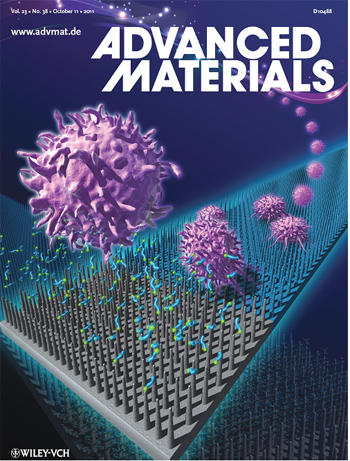Aptamer-Mediated Efficient Capture and Release of T Lymphocytes on Nanostructured Surfaces
The cells-substrate interaction is one of the most important scientific issues in biointerface, materials, medicine and other related fields. Considering the more similar environment with that in real biological body, three dimensional (3D) structural surfaces have attracted more attention than two dimensional (2D) surfaces. In previous work, researchers of the CAS Key Laboratory of Organic Solids revealed that the special 3D nano-structural surface could provide an excellent enhancement of the circulating tumor cells capture efficiency. (Angew. Chem. Int. Ed. 2011, 50, 3084).
Recently, under the supports of the National Natural Science Foundation of China, the Chinese Ministry of Science and Technology, the Chinese Academy of Sciences, and Institute of Chemistry, Prof. Shutao Wang’s group in the Key Laboratory of Organic Solids developed a specifically adhesive nanoplatform targeting to T lymphocytes. This nanostructured platform has high efficiency of T lymphocytes capture and release. As described by S.T. Wang and co-workers in their communication, they successfully modified the cell affinitive DNA aptamers, which could specifically recognize T lymphocytes, onto the silicon nanowire arrays (SiNW). As the co-effect of molecular identification and size match at nano-scale, the capture efficiency on this substrate increased up to two orders more than that of planar surfaces and the release efficiency was 97% ± 2% after treatment with exonuclease. The results have been published in Advanced Materials (Adv. Mater. 2011, 23, 4376). The paper is highlighted at the front cover of the journal. This method of capture and release provides an artful strategy to fulfill the demands of isolation and analysis of many kinds of cells, such as other leukocytes, circulating tumor cells, and stem cells. This study will have an important impact on rare cell detection and cell-based disease diagnosis.
These achievements have also been affirmed and highlighted by other organizations. Material view of China(Wiley)has reported this work at their homepage, and the authors also received an invitation from Science Publishers for writing a chapter named Emerging Nanotechnology for Efficient Capture of Circulating Tumor Cells in the nano-medical book Nanomedicine in Diagnostics. (Nanomedicine in Diagnostics,Chap 8,172-190)

(Image by Li Chen et al.)





